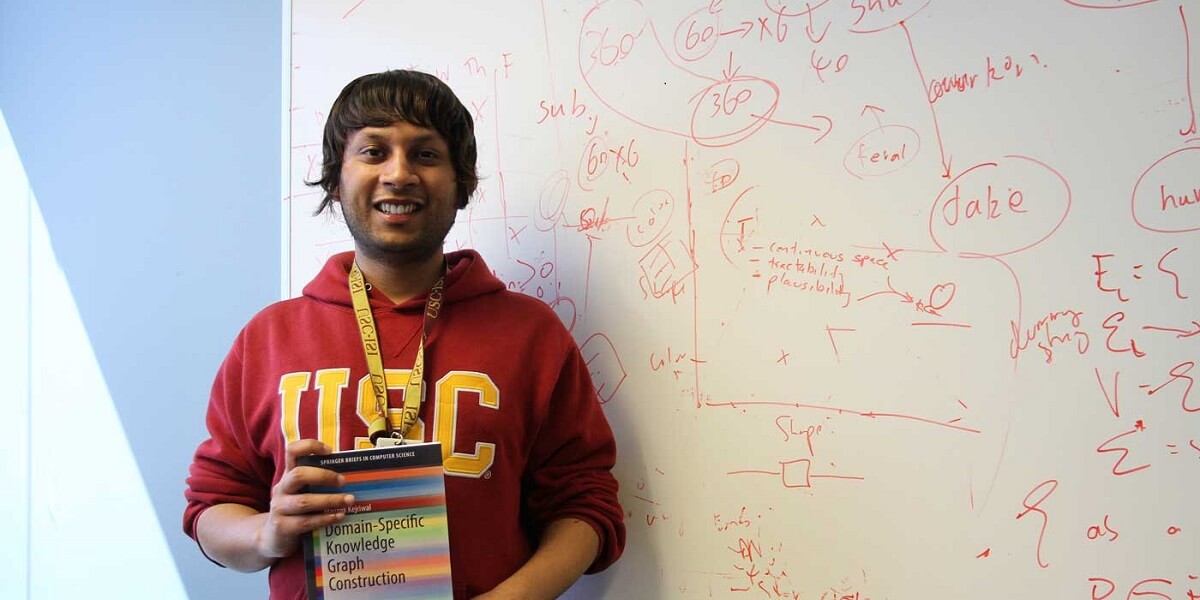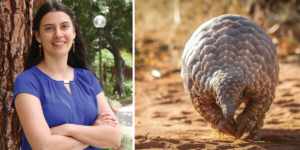
Mayank Kejriwal
ISI computer scientist Mayank Kejriwal, a 2019 Forbes 30 Under 30 finalist, uses his computer science skills to solve high- impact social problems like fighting human trafficking and responding to natural disasters. We sat down with him to learn more about his work and his experiences at ISI, where he is part of the Center on Knowledge Graphs.
So, you joined ISI in 2016. Tell us about that opportunity and what made you decide to come and work here?
One thing that appealed to me about ISI is that we tend to work on very big projects funded by the federal government. Before coming here, I had never been involved in projects at this scale. In fact, when I was doing my Ph.D. program, I wasn’t even sure whether I wanted to go into academia. But at ISI, I feel like we actively seek out revolutionary projects.
Not only are the projects influential, but we have an entrepreneurial mindset here as well. We won’t be slowed down by set tenure-track goals—instead, we find funding ourselves. We also combine research and real-world innovations. These were some of the reasons why I decided to join ISI and why I love working here.
Could you share some examples? What projects are you working on currently at ISI?
One of my current projects is the DARPA-funded THOR project, which stands for “Text-enabled Humanitarian Operations in Real-time,” and is a collaboration with Next Century Corporation. In funding this project, DARPA’s goal was to build a system that can extract real-time information from languages, especially those other than English, from social media and other online sources.
We take this information and group, analyze and visualize people’s needs during catastrophic events like natural disasters. For example, on a Twitter dataset collected right after the massive earthquake in Nepal a few years ago, we were able to figure out where people needed rescuing (mainly due to avalanches and building collapses), food, medicine and water. We’ve also done analyses on a Uyghur language dataset released by DARPA involving situations in China.
In the US, I’ve had students do research on tweets collected in the aftermath of Hurricane Harvey and even the tragic Las Vegas shootings in 2017. We can help government and organizations better understand these situations, make quick decisions and better allocate resources.
I‘m also continuing the work on human trafficking that we began several years ago under the Domain-specific Insight Graphs (DIG) project that was also funded by DARPA. Although I can’t say much about our effort in this space due to ongoing prosecutions and trials, I am working with law enforcement to find underage victims as well as trafficking organizations by applying AI to large datasets that we have access to. We are fortunate to be supported by an endowment from the Keston family in this important work.
We understand that some of your current projects are ongoing and you can’t give away much information, but are there some specific examples you can share with us about how these technologies can actually help our society?
For the DIG project, we have received testimonials from district attorneys from New York and San Francisco. The district attorney in San Francisco was able to use the system to collect and present evidence and eventually was able to give out a sentence of over 97 years to life for human trafficking offences, which is very unusual in California. Also, we have heard informally from law enforcement that they were able to find human trafficking victims with the help of the system.
With the THOR project, we have been working on an example using the Uyghur language spoken by minorities in northern China. How can you quickly understand information in Uyghur and how could an organization like the UN determine how to help out in a natural disaster, without experts in this language? So, our natural language team has been trying to build a better machine translator for Uyghur. From there, in the case of a natural disaster, we can take this messy dataset and information and transform it into time-labeled and mapped information to help determine where people need help in real- time. In my view, the THOR project truly illustrates the potential for interdisciplinary AI to be used for social impact.
These projects sound so exciting! But, on a personal level, why are you so interested in projects aiming to solve social problems using computer science?
When I first came to ISI in 2016, I did not have any experience using AI and computer science for social applications. I was like any other computer scientist, in the sense that I was developing research and the research was getting published. That was the mode I was in and what I expected from an academic career.
But when I came to ISI, I joined the DARPA MEMEX project, building the system to fight human trafficking. Over time, I talked and interacted with law enforcement people and started to gain a better understanding about the kinds of problems they faced. And I could see face-to-face the impact, knowing what they can accomplish using the system. I realized then that there was bigger world out there—it’s not just about publishing research and getting citations.
So far, we have heard so much about your projects here at ISI, let’s step back a little bit. Can you share with us how’s your journey of being a computer scientist began?
That’s a very interesting question. So, I came to the United States at the age of 19 for my undergraduate degree at University of Illinois at Urbana-Champaign (UIUC) studying computer engineering. But in fact, I was born in India to a business and entrepreneurial family; no one in my family was in the engineering field, but I gradually grew interested in the sciences.
Then, I encountered computer science and I knew I could do well in this field. I still remember one undergrad class at UIUC I took about artificial intelligence. In that class, I was shown different fields and topics of AI that really opened my eyes. I got my first taste of research serving as an undergraduate researcher, which later led to my academic exploration — a Ph.D. at UT Austin and later, a researcher at ISI. Interestingly, I ran into the professor who first taught me machine learning at UIUC; he’s being funded under the same DARPA program that funds THOR! So it feels like I’ve come full circle.
Wow, what an interesting journey! So, say there’s younger computer scientist who’s passionate about working in this area, what would be your best advice to them?
Go for the big projects and shoot for the big ideas! Eventually, the wins are what count and the losses will fade away. There’s no record for losses. You don’t put your losses on your resume. Sure, you will feel bad about your losses, but it’s the big ideas you take on that end up defining you.
Published on August 20th, 2019
Last updated on May 17th, 2021













